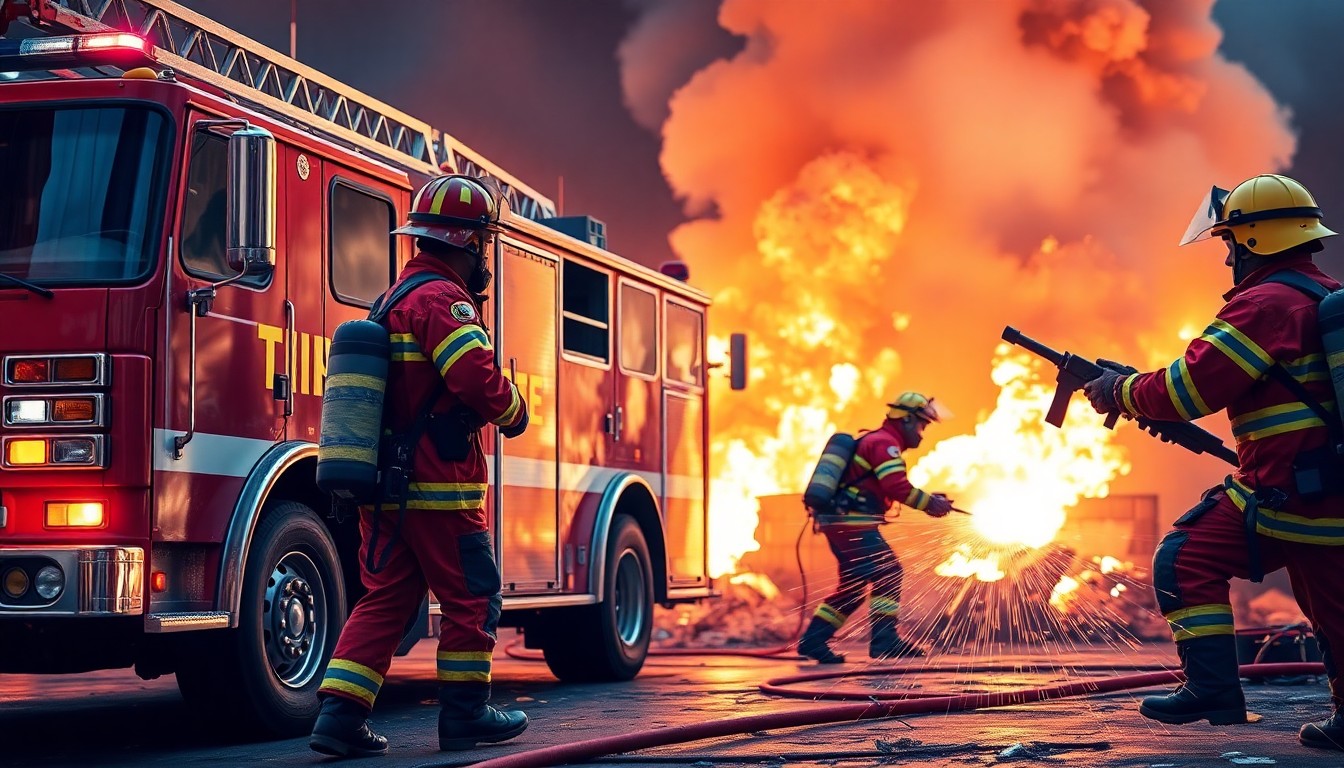
The Importance of Steel in Emergency Services!
Share
Introduction
Steel plays a crucial role in emergency services due to its exceptional strength and durability, which are essential in critical situations. Whether in the construction of emergency response vehicles, shelters, or life-saving tools and equipment, the robust nature of steel ensures that these resources can withstand the rigors of demanding environments. In emergency scenarios such as natural disasters, accidents, or rescue operations, the reliability of steel becomes paramount in ensuring the safety and effectiveness of response efforts.
Its ability to withstand high impact and extreme conditions makes it an indispensable material in emergency services. Furthermore, the strength of steel provides a sense of security and confidence to emergency responders and victims alike. Knowing that the tools, vehicles, and structures utilized in these situations are constructed with material as resilient as steel can alleviate concerns about potential equipment failure or structural compromise.
This peace of mind is invaluable in high-stress, life-threatening situations where the reliability of resources can make a critical difference in the outcome.
Key Takeaways
- Steel is crucial in emergency services due to its strength and durability in critical situations.
- Emergency response vehicles rely on steel for structural integrity and safety.
- Life-saving equipment, such as cutting tools and stretchers, are made from steel.
- Steel is essential in the construction of emergency shelters, ensuring structural integrity and safety.
- Steel plays a vital role in medical and disaster response supplies, contributing to the overall effectiveness of emergency services.
Essential Role of Steel in Emergency Response Vehicles
Emergency response vehicles are a cornerstone of any effective emergency service, and steel is integral to their construction. From fire trucks to ambulances and police cars, these vehicles rely on steel for their structural integrity and protective capabilities. The use of steel in the chassis and body of these vehicles ensures that they can endure the demands of rapid response, adverse weather conditions, and potential collisions.
Additionally, steel's ability to absorb impact energy makes it an ideal material for reinforcing vehicle frames, enhancing occupant safety, and safeguarding critical equipment and supplies during transit. Moreover, steel's malleability allows for intricate designs and customization to meet the specific needs of different emergency response vehicles. This flexibility in design ensures that each vehicle can be tailored to accommodate the unique requirements of its intended use, whether it be firefighting, medical response, or law enforcement.
The adaptability of steel in vehicle construction contributes to the overall efficiency and effectiveness of emergency services by providing reliable transportation that can swiftly navigate through challenging terrains and reach those in need.
Life-Saving Tools and Equipment Made from Steel
In emergency services, the tools and equipment utilized are often the difference between life and death. Steel is a fundamental component in the manufacturing of various life-saving tools such as cutting implements, extraction devices, and protective gear. For instance, hydraulic rescue tools, commonly known as "jaws of life," used by first responders to extricate individuals from vehicles involved in accidents, rely on the strength and durability of steel to effectively cut through metal and debris.
Similarly, medical instruments such as surgical scalpels, forceps, and trauma shears are crafted from high-quality steel to ensure precision, sharpness, and reliability during critical procedures. Furthermore, protective gear worn by emergency responders, including helmets, body armor, and safety harnesses, are often reinforced with steel components to provide essential protection against impact and penetration. The use of steel in these life-saving tools and equipment not only enhances their performance but also instills confidence in the individuals employing them, knowing that they can rely on the durability and resilience of steel when every second counts.
Structural Integrity and Safety in Emergency Shelters
| Shelter Type | Structural Integrity Rating | Safety Rating |
|---|---|---|
| Tents | Low | Low |
| Temporary Shelters | Medium | Medium |
| Permanent Shelters | High | High |
Steel's contribution to emergency services extends beyond vehicles and tools to encompass the construction of emergency shelters. Whether it's temporary housing for displaced individuals during natural disasters or field hospitals set up in crisis zones, the structural integrity and safety provided by steel are paramount. Steel-framed shelters offer robust support and stability, ensuring that they can withstand adverse weather conditions and provide a secure environment for those seeking refuge.
Moreover, the versatility of steel allows for the rapid deployment of emergency shelters, making them an essential resource in disaster response efforts. The ease of assembly and disassembly of steel-framed structures enables the swift establishment of temporary housing and medical facilities in areas affected by emergencies. This capability is invaluable in providing immediate relief and support to communities impacted by disasters or crises.
Steel's Contribution to Firefighting and Rescue Operations
In the realm of firefighting and rescue operations, steel plays a pivotal role in ensuring the effectiveness and safety of responders. Firefighting equipment such as ladders, axes, nozzles, and protective gear heavily rely on steel for their construction. The heat resistance and structural strength of steel make it an ideal material for withstanding the extreme conditions encountered during firefighting efforts.
Additionally, steel is integral to the construction of fire-resistant structures and barriers that help contain and mitigate the spread of fires. Fire doors, fire escapes, and fire-resistant partitions within buildings are often reinforced with steel components to enhance their ability to withstand high temperatures and prevent the rapid progression of fires. These measures contribute significantly to the safety of occupants and facilitate the work of firefighters in controlling and extinguishing blazes.
Importance of Steel in Medical and Disaster Response Supplies
Steel's significance in emergency services extends to the realm of medical and disaster response supplies. From medical instruments to storage containers for essential supplies, steel is a prevalent material due to its hygienic properties, durability, and ease of sterilization. Surgical instruments made from high-quality stainless steel are essential for performing precise procedures in emergency medical settings.
Furthermore, steel containers for storing pharmaceuticals, medical equipment, and emergency provisions offer secure protection against environmental factors and potential damage. The resilience of steel ensures that vital supplies remain intact and accessible during transportation and storage, safeguarding their usability when urgently needed.
Future Innovations and Advancements in Steel for Emergency Services
As technology continues to advance, so does the potential for innovations in steel that can further enhance its role in emergency services. Ongoing research and development efforts are focused on creating advanced forms of steel with improved strength-to-weight ratios, corrosion resistance, and impact absorption capabilities. These advancements hold promise for the development of lighter yet stronger materials that can optimize the performance of emergency response vehicles, tools, shelters, and equipment.
Moreover, advancements in manufacturing processes such as additive manufacturing (3D printing) present opportunities for creating complex steel components with enhanced precision and customization. This could lead to the production of specialized tools and equipment tailored to specific emergency service needs with unprecedented efficiency. In conclusion, the importance of steel in emergency services cannot be overstated.
Its strength, durability, versatility, and reliability make it an indispensable material across various facets of emergency response efforts. From providing structural integrity in shelters to enhancing the performance of life-saving tools and vehicles, steel continues to play a vital role in safeguarding lives and supporting the effectiveness of emergency services. As advancements in materials science continue to unfold, the future holds exciting possibilities for further leveraging the exceptional properties of steel to meet the evolving demands of emergency response scenarios.
Conclusion
Steel plays a crucial role in emergency services due to its strength and durability. It is used in the construction of fire stations, rescue equipment, and emergency vehicles, ensuring reliability and safety. Steel structures withstand extreme conditions, providing essential support during crises. Its versatility allows for rapid deployment and adaptability in various emergency scenarios. Ultimately, steel's contribution is vital in maintaining efficiency and effectiveness in emergency response efforts.

